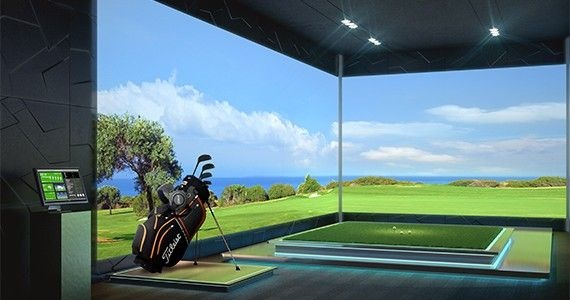Investing in a home golf simulator can be a game-changer for golf enthusiasts, allowing you to practice your swing and improve your game without leaving the comfort of your home. However, before setting up your simulator, it’s crucial to understand the space requirements to ensure optimal performance and safety. This article explores how much space you need for a home golf simulator, with a focus on various factors such as room dimensions, ceiling height, and layout considerations.
Understanding the Basics of Golf Simulator Space Requirements
A home golf simulator generally consists of a hitting mat, a screen or net to catch the ball, a projector, and sensors or cameras to track your shots. The space you need will depend on the type of golf simulator you choose and the components included. The two main types are full-swing simulators and compact simulators, with the former requiring more space due to their advanced features and realistic experience.
Minimum Room Dimensions for a Golf Simulator
To set up a basic golf simulator, you need to consider three primary dimensions: length, width, and height.
Length
The length of the room is crucial to ensure you have enough space to swing comfortably and for the ball to travel to the screen or net. A minimum room length of 10 to 12 feet is recommended. However, for a more realistic experience and to accommodate different clubs, a length of 15 to 18 feet is ideal. This allows the ball to fly naturally and the sensors or cameras to capture accurate data.
Width
The width of the room is important to provide enough space for your swing and to avoid hitting walls or other objects. A minimum width of 10 feet is generally sufficient, but 12 to 15 feet is preferable. This ensures that both right-handed and left-handed golfers can swing without restrictions and that the setup can accommodate different stance widths and swing paths.
Height
Ceiling height is often the most overlooked aspect of setting up a golf simulator, yet it is one of the most critical factors. A minimum ceiling height of 8.5 feet is required, but a height of 9 to 10 feet is ideal to accommodate a full swing with all clubs, including drivers. If the ceiling is too low, you risk damaging it with your club or having an unnatural, restricted swing.
Additional Space Considerations
Beyond the basic room dimensions, several additional factors can influence the space requirements for your home golf simulator.
Swing Area
The swing area should be free of any obstructions, including furniture, lights, and other fixtures. Ensure you have ample space around you to swing comfortably and safely. A dedicated area of 5 to 7 feet on either side of the hitting mat is recommended.
Projection and Screen Distance
The distance between the projector and the screen or net is another critical consideration. This distance can vary depending on the type of projector you use and the desired screen size. Typically, a distance of 6 to 10 feet is needed for the projector to display a clear and undistorted image on the screen.
Safety Zone
To prevent any accidents or damage, it’s important to establish a safety zone around your golf simulator setup. This includes keeping a buffer zone of at least 3 to 5 feet behind the hitting area and around the screen or net to catch any errant shots.
Ideal Layout for a Home Golf Simulator
Once you’ve determined the necessary dimensions and space considerations, planning the layout of your home golf simulator is essential for creating an optimal practice environment.
Placement of the Hitting Mat
The hitting mat should be placed in the center of the room, ensuring equal space on both sides for right-handed and left-handed golfers. This central placement allows for a balanced and symmetrical setup, making it easier to align your shots and achieve accurate data from the sensors or cameras.
Positioning the Screen or Net
The screen or net should be placed at the far end of the room, directly in front of the hitting mat. Ensure the screen is securely mounted and can withstand the impact of high-speed golf balls. The net should be taut and free of any holes or weak spots to safely catch the ball.
Projector and Sensor Setup
The projector should be mounted on the ceiling or behind the hitting area to project the image onto the screen without casting shadows. Ensure the projector is aligned correctly to avoid any distortion in the display. Sensors or cameras should be positioned to capture accurate data from your shots. This typically involves placing them near the hitting mat or on the ceiling above the swing area.
Considerations for Different Types of Golf Simulators
The space requirements can vary depending on the type of golf simulator you choose. Here’s a brief overview of the considerations for full-swing simulators and compact simulators.
Full-Swing Simulators
Full-swing simulators offer the most realistic experience, with advanced tracking systems and high-quality graphics. These simulators typically require more space due to their comprehensive setup, including a large screen, multiple sensors, and a powerful projector. For a full-swing simulator, a room with dimensions of at least 15 feet in length, 12 feet in width, and 10 feet in height is recommended.
Compact Simulators
Compact simulators are designed for smaller spaces and offer a more affordable option for home use. These simulators often use a net instead of a screen and have fewer sensors. While they may not provide the same level of realism as full-swing simulators, they still offer valuable practice opportunities. For a compact simulator, a room with dimensions of 10 feet in length, 10 feet in width, and 8.5 feet in height can suffice.
Customizing Your Golf Simulator Space
Customizing your golf simulator space can enhance your practice experience and make the most of the available area. Here are a few tips for optimizing your setup:
Using Multi-Purpose Rooms
If you don’t have a dedicated space for your golf simulator, consider using a multi-purpose room such as a garage, basement, or spare bedroom. Ensure the room can accommodate the necessary dimensions and that you can easily clear the space when using the simulator.
Adjustable Components
Opt for adjustable components such as a retractable screen or a portable hitting mat. This flexibility allows you to store the simulator setup when not in use and make the most of your available space.
Enhancing the Environment
Creating a comfortable and realistic environment can improve your practice sessions. Consider adding features such as turf flooring, ambient lighting, and soundproofing to enhance the overall experience. These additions can help mimic the feel of an outdoor course and make your practice sessions more enjoyable.
Final Thoughts
Setting up a Top Golf Simulator requires careful planning and consideration of the available space. By understanding the minimum room dimensions, layout considerations, and customization options, you can create an optimal practice environment that meets your needs. Whether you choose a full-swing simulator or a compact simulator, ensuring you have enough space for a comfortable and safe setup is essential for maximizing your investment and improving your game.



